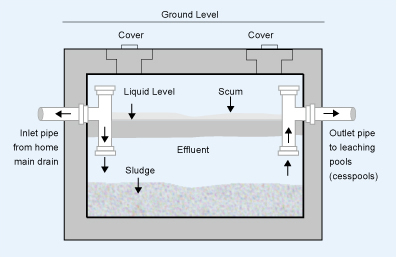|
|
Septics 101
Source: Long Island Liquid Waste Association (L.I.L.W.A.)
Understanding Your Septic System
Do's and Don'ts
Do
- 1. Know where your septic system is located.
- 2. Have your septic tank (main receiver) pumped and
insptected every 2 years by a licensed septic tank company.
- 3. Direct all storm water run-off away from the septic
system.
- 4. Conserve water by using water-saving plumbing fixtures.
- 5. Fix all leaking plumbing fixtures.
Doníts
- 1. Drive or park over the septic system.
- 2. Plant trees or build anything over your septic system.
- 3. Dispose of non-biodegradable materials in the system.
- 4. Dispose of kitchen grease and food scraps in the
system.
What is a Septic System?
 Septic systems have been installed since the late 1800ís
replacing the old outsite facility commonly known as the
outhouse.
Septic systems have been installed since the late 1800ís
replacing the old outsite facility commonly known as the
outhouse.
A septic system on Long Island usually consists of a primary
receiver (septic tank) and a drainage area (cesspool or drainage
field). Homes constructed after 1972 will have a septic tank as
the primary receiver. Some homes built prior to 1972 will have a
cesspool as a primary receiver. Most homes have a septic tank
serving as the primary receiver and a cesspool or multiple
cesspools serving as the drainage area. If properly installed
and maintained on a regular basis, your septic system will
provide many years of trouble free use.
How Do Septic Systems Work?
Waste water leaves your home through a pipeline called the main
line, then enters the septic tank (primary receiver). The septic
tank holds the waste for primary treatment where solids and
liquids are separated by gravity. The heavy digested solids
called sludge accumulate at the bottom of the tank. The lighter
materials (grease and oils) are called a scum layer that floats
to the top of the liquid. Natural bacteria generated by the
solid waste partially decomposes the waste in the septic tank
and reduces the amount of solid materials by as much as 60%. The
septic tank is only one part of your septic system. It is
designed to remove the solids from your waste water as shown
above, prior to the waste water entering the cesspool (drainage
area). Solids and sludge should be pumped from the septic tank
every 2 years (as recommended by the county health department)
by a licensed septic hauler to prevent solid materials from
entering the cesspool. This will avoid costly repairs to the
cesspool drainage area commonly referred to as the overflow.
What is an Overflow?
The cesspool (drainage area) commonly referred to as an overflow
is designed to leach water only. The cesspool should revise
water only Ė solid waste will clog drainage area. The
homeowner should have their pumping contractor inspect the
overflow system when the solids and sludge are pumped from the
septic tank to insure proper drainage. If it is determined that
the overflow requires service, the homeowner may elect pumping,
aeration and application of drainage additives to the overflow
to restore drainage.
|